Tax Law Assignment: Employment, Income, and Deductible Expenses
VerifiedAdded on 2021/04/21
|8
|1479
|24
Homework Assignment
AI Summary
This tax law assignment delves into the complexities of employment status determination and income tax implications under the Income Tax Act 2007. The assignment begins by addressing the employment status of William, evaluating the application of various legal tests such as the control test, integration test, economic reality test, intention test, and independence test to ascertain whether William is an employee or an independent contractor. The assignment then examines the importance of determining employment status for tax purposes, highlighting the differences in tax obligations between employees and independent contractors. The second part of the assignment analyzes the taxability of various income sources, including volunteer reimbursements, lottery winnings, employment-related prizes, capital gains, and fully imputed dividends. It also assesses the deductibility of various expenses, such as car purchases, prepaid rent, business-related travel expenses, insurance premiums, penalties for late tax payments, and fringe benefits, in accordance with relevant sections of the ITA 2007 and other tax regulations. The assignment concludes with a detailed analysis of each scenario, providing clear justifications for the tax treatment of different income and expense items.
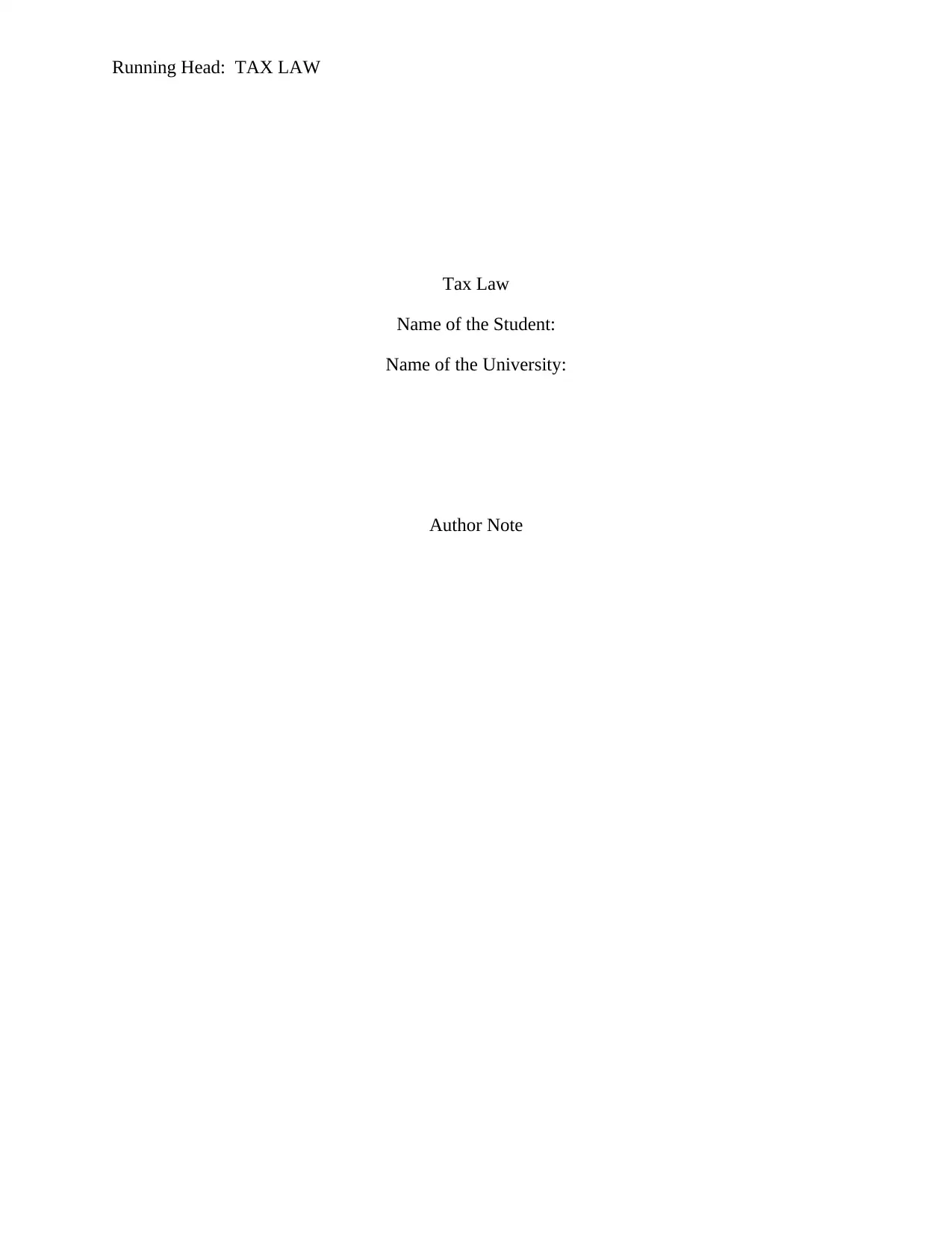
Running Head: TAX LAW
Tax Law
Name of the Student:
Name of the University:
Author Note
Tax Law
Name of the Student:
Name of the University:
Author Note
Paraphrase This Document
Need a fresh take? Get an instant paraphrase of this document with our AI Paraphraser
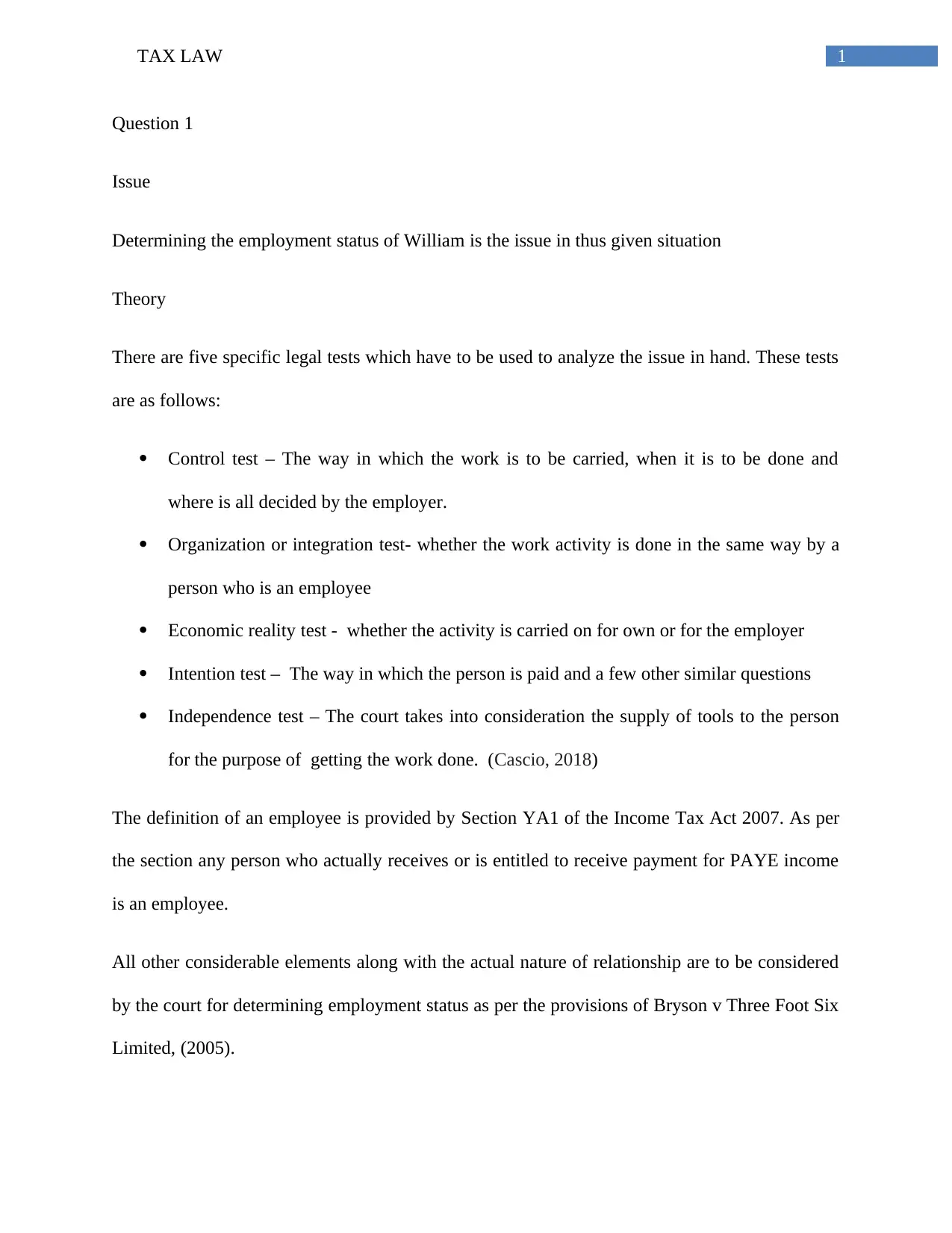
1TAX LAW
Question 1
Issue
Determining the employment status of William is the issue in thus given situation
Theory
There are five specific legal tests which have to be used to analyze the issue in hand. These tests
are as follows:
Control test – The way in which the work is to be carried, when it is to be done and
where is all decided by the employer.
Organization or integration test- whether the work activity is done in the same way by a
person who is an employee
Economic reality test - whether the activity is carried on for own or for the employer
Intention test – The way in which the person is paid and a few other similar questions
Independence test – The court takes into consideration the supply of tools to the person
for the purpose of getting the work done. (Cascio, 2018)
The definition of an employee is provided by Section YA1 of the Income Tax Act 2007. As per
the section any person who actually receives or is entitled to receive payment for PAYE income
is an employee.
All other considerable elements along with the actual nature of relationship are to be considered
by the court for determining employment status as per the provisions of Bryson v Three Foot Six
Limited, (2005).
Question 1
Issue
Determining the employment status of William is the issue in thus given situation
Theory
There are five specific legal tests which have to be used to analyze the issue in hand. These tests
are as follows:
Control test – The way in which the work is to be carried, when it is to be done and
where is all decided by the employer.
Organization or integration test- whether the work activity is done in the same way by a
person who is an employee
Economic reality test - whether the activity is carried on for own or for the employer
Intention test – The way in which the person is paid and a few other similar questions
Independence test – The court takes into consideration the supply of tools to the person
for the purpose of getting the work done. (Cascio, 2018)
The definition of an employee is provided by Section YA1 of the Income Tax Act 2007. As per
the section any person who actually receives or is entitled to receive payment for PAYE income
is an employee.
All other considerable elements along with the actual nature of relationship are to be considered
by the court for determining employment status as per the provisions of Bryson v Three Foot Six
Limited, (2005).
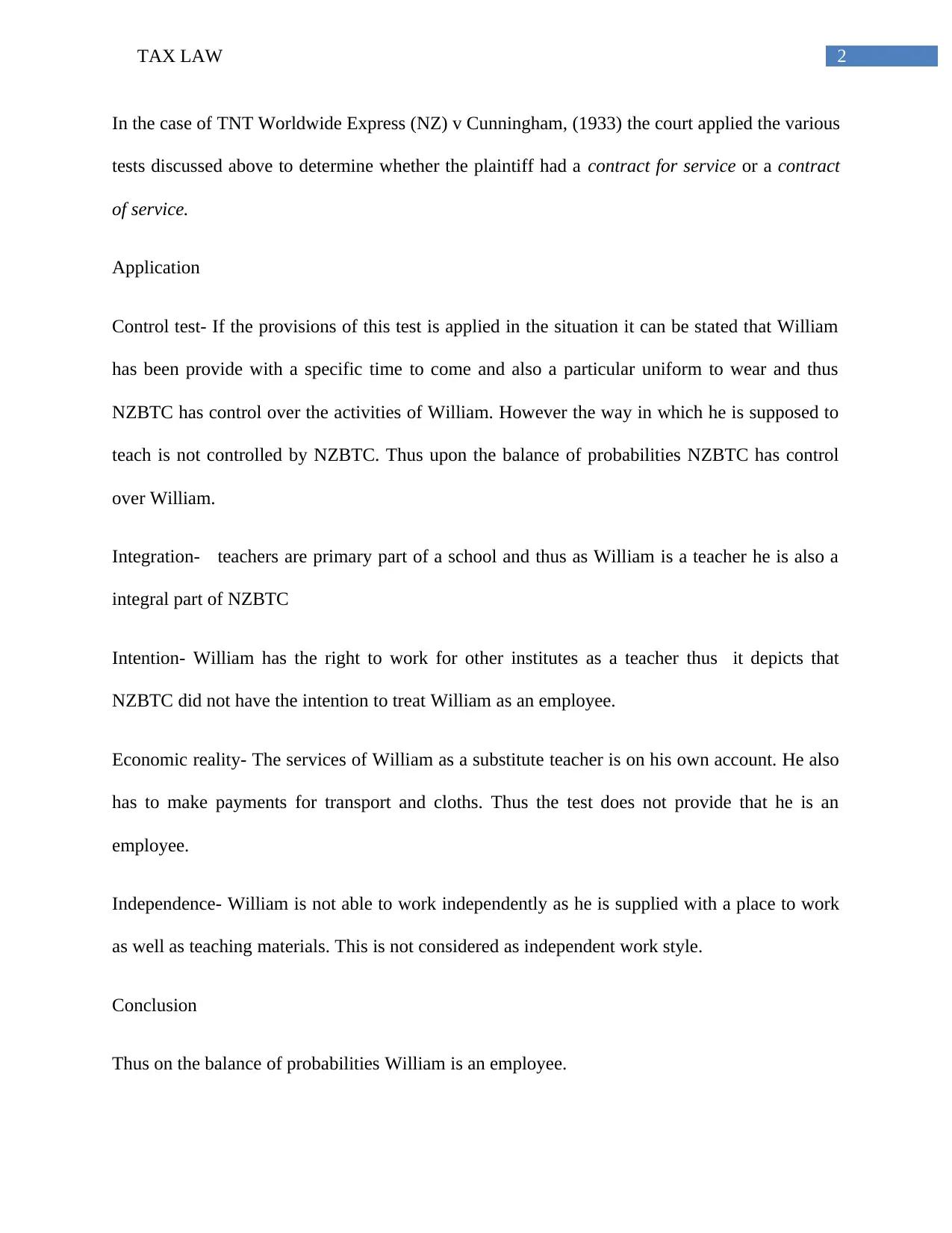
2TAX LAW
In the case of TNT Worldwide Express (NZ) v Cunningham, (1933) the court applied the various
tests discussed above to determine whether the plaintiff had a contract for service or a contract
of service.
Application
Control test- If the provisions of this test is applied in the situation it can be stated that William
has been provide with a specific time to come and also a particular uniform to wear and thus
NZBTC has control over the activities of William. However the way in which he is supposed to
teach is not controlled by NZBTC. Thus upon the balance of probabilities NZBTC has control
over William.
Integration- teachers are primary part of a school and thus as William is a teacher he is also a
integral part of NZBTC
Intention- William has the right to work for other institutes as a teacher thus it depicts that
NZBTC did not have the intention to treat William as an employee.
Economic reality- The services of William as a substitute teacher is on his own account. He also
has to make payments for transport and cloths. Thus the test does not provide that he is an
employee.
Independence- William is not able to work independently as he is supplied with a place to work
as well as teaching materials. This is not considered as independent work style.
Conclusion
Thus on the balance of probabilities William is an employee.
In the case of TNT Worldwide Express (NZ) v Cunningham, (1933) the court applied the various
tests discussed above to determine whether the plaintiff had a contract for service or a contract
of service.
Application
Control test- If the provisions of this test is applied in the situation it can be stated that William
has been provide with a specific time to come and also a particular uniform to wear and thus
NZBTC has control over the activities of William. However the way in which he is supposed to
teach is not controlled by NZBTC. Thus upon the balance of probabilities NZBTC has control
over William.
Integration- teachers are primary part of a school and thus as William is a teacher he is also a
integral part of NZBTC
Intention- William has the right to work for other institutes as a teacher thus it depicts that
NZBTC did not have the intention to treat William as an employee.
Economic reality- The services of William as a substitute teacher is on his own account. He also
has to make payments for transport and cloths. Thus the test does not provide that he is an
employee.
Independence- William is not able to work independently as he is supplied with a place to work
as well as teaching materials. This is not considered as independent work style.
Conclusion
Thus on the balance of probabilities William is an employee.
⊘ This is a preview!⊘
Do you want full access?
Subscribe today to unlock all pages.

Trusted by 1+ million students worldwide
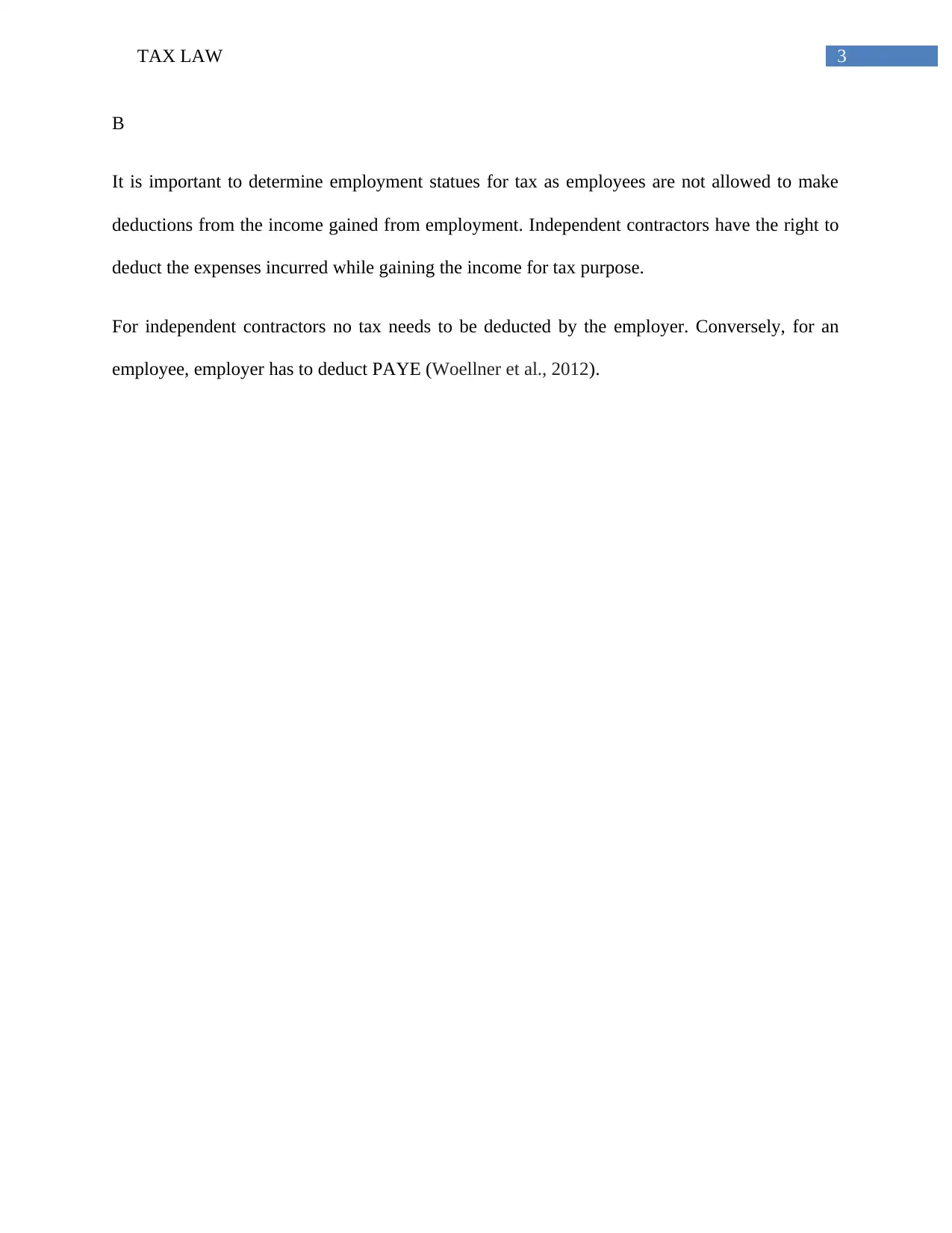
3TAX LAW
B
It is important to determine employment statues for tax as employees are not allowed to make
deductions from the income gained from employment. Independent contractors have the right to
deduct the expenses incurred while gaining the income for tax purpose.
For independent contractors no tax needs to be deducted by the employer. Conversely, for an
employee, employer has to deduct PAYE (Woellner et al., 2012).
B
It is important to determine employment statues for tax as employees are not allowed to make
deductions from the income gained from employment. Independent contractors have the right to
deduct the expenses incurred while gaining the income for tax purpose.
For independent contractors no tax needs to be deducted by the employer. Conversely, for an
employee, employer has to deduct PAYE (Woellner et al., 2012).
Paraphrase This Document
Need a fresh take? Get an instant paraphrase of this document with our AI Paraphraser
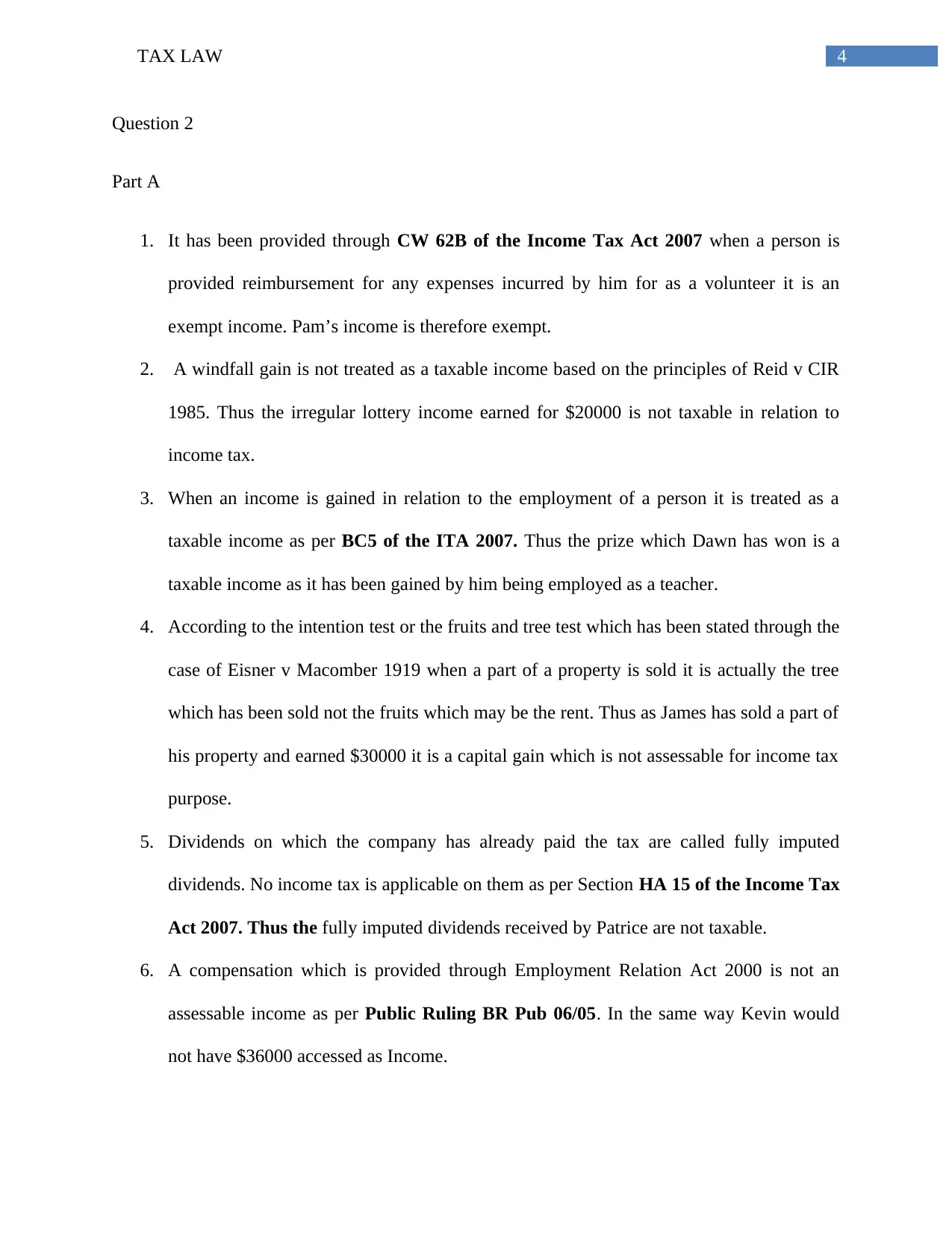
4TAX LAW
Question 2
Part A
1. It has been provided through CW 62B of the Income Tax Act 2007 when a person is
provided reimbursement for any expenses incurred by him for as a volunteer it is an
exempt income. Pam’s income is therefore exempt.
2. A windfall gain is not treated as a taxable income based on the principles of Reid v CIR
1985. Thus the irregular lottery income earned for $20000 is not taxable in relation to
income tax.
3. When an income is gained in relation to the employment of a person it is treated as a
taxable income as per BC5 of the ITA 2007. Thus the prize which Dawn has won is a
taxable income as it has been gained by him being employed as a teacher.
4. According to the intention test or the fruits and tree test which has been stated through the
case of Eisner v Macomber 1919 when a part of a property is sold it is actually the tree
which has been sold not the fruits which may be the rent. Thus as James has sold a part of
his property and earned $30000 it is a capital gain which is not assessable for income tax
purpose.
5. Dividends on which the company has already paid the tax are called fully imputed
dividends. No income tax is applicable on them as per Section HA 15 of the Income Tax
Act 2007. Thus the fully imputed dividends received by Patrice are not taxable.
6. A compensation which is provided through Employment Relation Act 2000 is not an
assessable income as per Public Ruling BR Pub 06/05. In the same way Kevin would
not have $36000 accessed as Income.
Question 2
Part A
1. It has been provided through CW 62B of the Income Tax Act 2007 when a person is
provided reimbursement for any expenses incurred by him for as a volunteer it is an
exempt income. Pam’s income is therefore exempt.
2. A windfall gain is not treated as a taxable income based on the principles of Reid v CIR
1985. Thus the irregular lottery income earned for $20000 is not taxable in relation to
income tax.
3. When an income is gained in relation to the employment of a person it is treated as a
taxable income as per BC5 of the ITA 2007. Thus the prize which Dawn has won is a
taxable income as it has been gained by him being employed as a teacher.
4. According to the intention test or the fruits and tree test which has been stated through the
case of Eisner v Macomber 1919 when a part of a property is sold it is actually the tree
which has been sold not the fruits which may be the rent. Thus as James has sold a part of
his property and earned $30000 it is a capital gain which is not assessable for income tax
purpose.
5. Dividends on which the company has already paid the tax are called fully imputed
dividends. No income tax is applicable on them as per Section HA 15 of the Income Tax
Act 2007. Thus the fully imputed dividends received by Patrice are not taxable.
6. A compensation which is provided through Employment Relation Act 2000 is not an
assessable income as per Public Ruling BR Pub 06/05. In the same way Kevin would
not have $36000 accessed as Income.
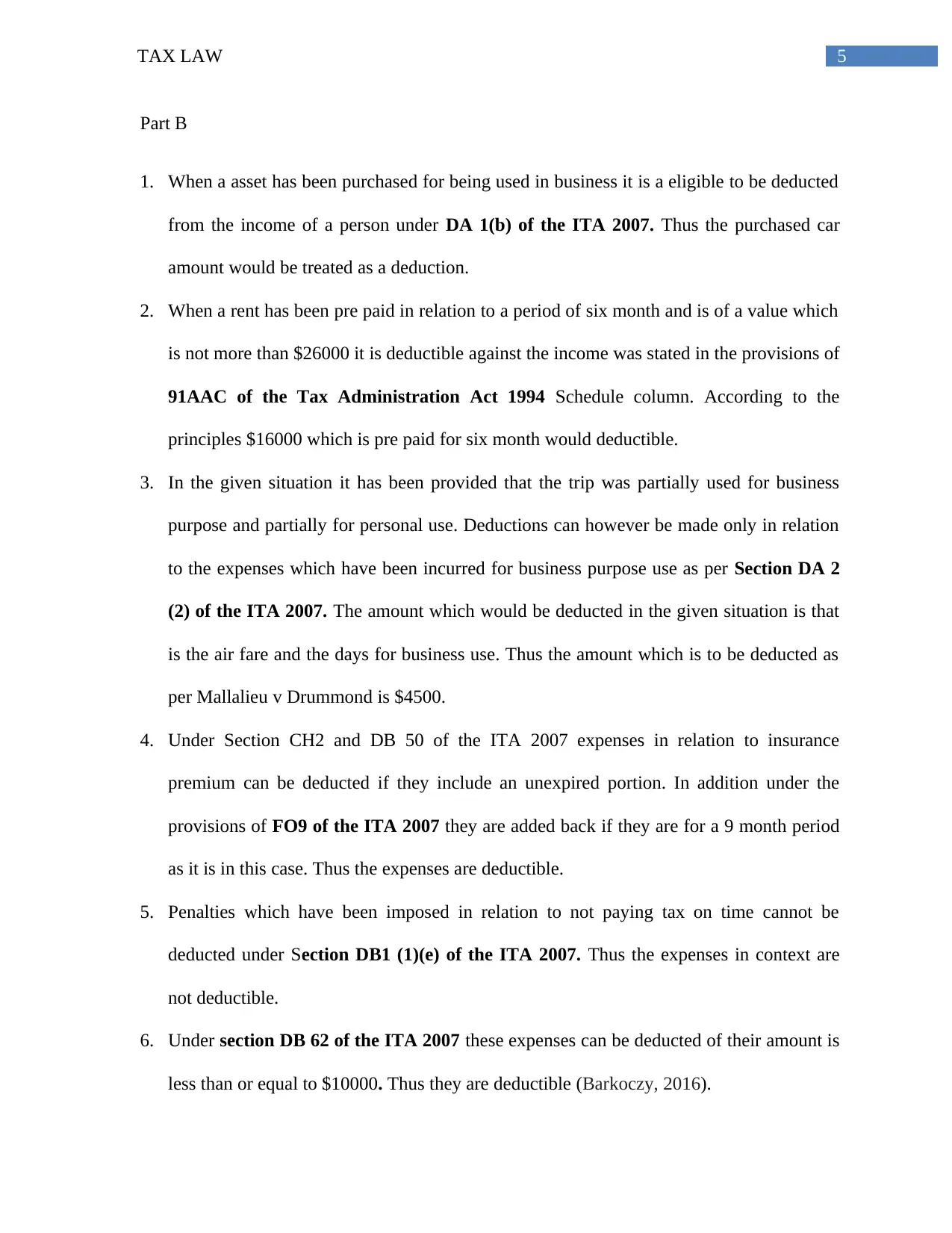
5TAX LAW
Part B
1. When a asset has been purchased for being used in business it is a eligible to be deducted
from the income of a person under DA 1(b) of the ITA 2007. Thus the purchased car
amount would be treated as a deduction.
2. When a rent has been pre paid in relation to a period of six month and is of a value which
is not more than $26000 it is deductible against the income was stated in the provisions of
91AAC of the Tax Administration Act 1994 Schedule column. According to the
principles $16000 which is pre paid for six month would deductible.
3. In the given situation it has been provided that the trip was partially used for business
purpose and partially for personal use. Deductions can however be made only in relation
to the expenses which have been incurred for business purpose use as per Section DA 2
(2) of the ITA 2007. The amount which would be deducted in the given situation is that
is the air fare and the days for business use. Thus the amount which is to be deducted as
per Mallalieu v Drummond is $4500.
4. Under Section CH2 and DB 50 of the ITA 2007 expenses in relation to insurance
premium can be deducted if they include an unexpired portion. In addition under the
provisions of FO9 of the ITA 2007 they are added back if they are for a 9 month period
as it is in this case. Thus the expenses are deductible.
5. Penalties which have been imposed in relation to not paying tax on time cannot be
deducted under Section DB1 (1)(e) of the ITA 2007. Thus the expenses in context are
not deductible.
6. Under section DB 62 of the ITA 2007 these expenses can be deducted of their amount is
less than or equal to $10000. Thus they are deductible (Barkoczy, 2016).
Part B
1. When a asset has been purchased for being used in business it is a eligible to be deducted
from the income of a person under DA 1(b) of the ITA 2007. Thus the purchased car
amount would be treated as a deduction.
2. When a rent has been pre paid in relation to a period of six month and is of a value which
is not more than $26000 it is deductible against the income was stated in the provisions of
91AAC of the Tax Administration Act 1994 Schedule column. According to the
principles $16000 which is pre paid for six month would deductible.
3. In the given situation it has been provided that the trip was partially used for business
purpose and partially for personal use. Deductions can however be made only in relation
to the expenses which have been incurred for business purpose use as per Section DA 2
(2) of the ITA 2007. The amount which would be deducted in the given situation is that
is the air fare and the days for business use. Thus the amount which is to be deducted as
per Mallalieu v Drummond is $4500.
4. Under Section CH2 and DB 50 of the ITA 2007 expenses in relation to insurance
premium can be deducted if they include an unexpired portion. In addition under the
provisions of FO9 of the ITA 2007 they are added back if they are for a 9 month period
as it is in this case. Thus the expenses are deductible.
5. Penalties which have been imposed in relation to not paying tax on time cannot be
deducted under Section DB1 (1)(e) of the ITA 2007. Thus the expenses in context are
not deductible.
6. Under section DB 62 of the ITA 2007 these expenses can be deducted of their amount is
less than or equal to $10000. Thus they are deductible (Barkoczy, 2016).
⊘ This is a preview!⊘
Do you want full access?
Subscribe today to unlock all pages.

Trusted by 1+ million students worldwide
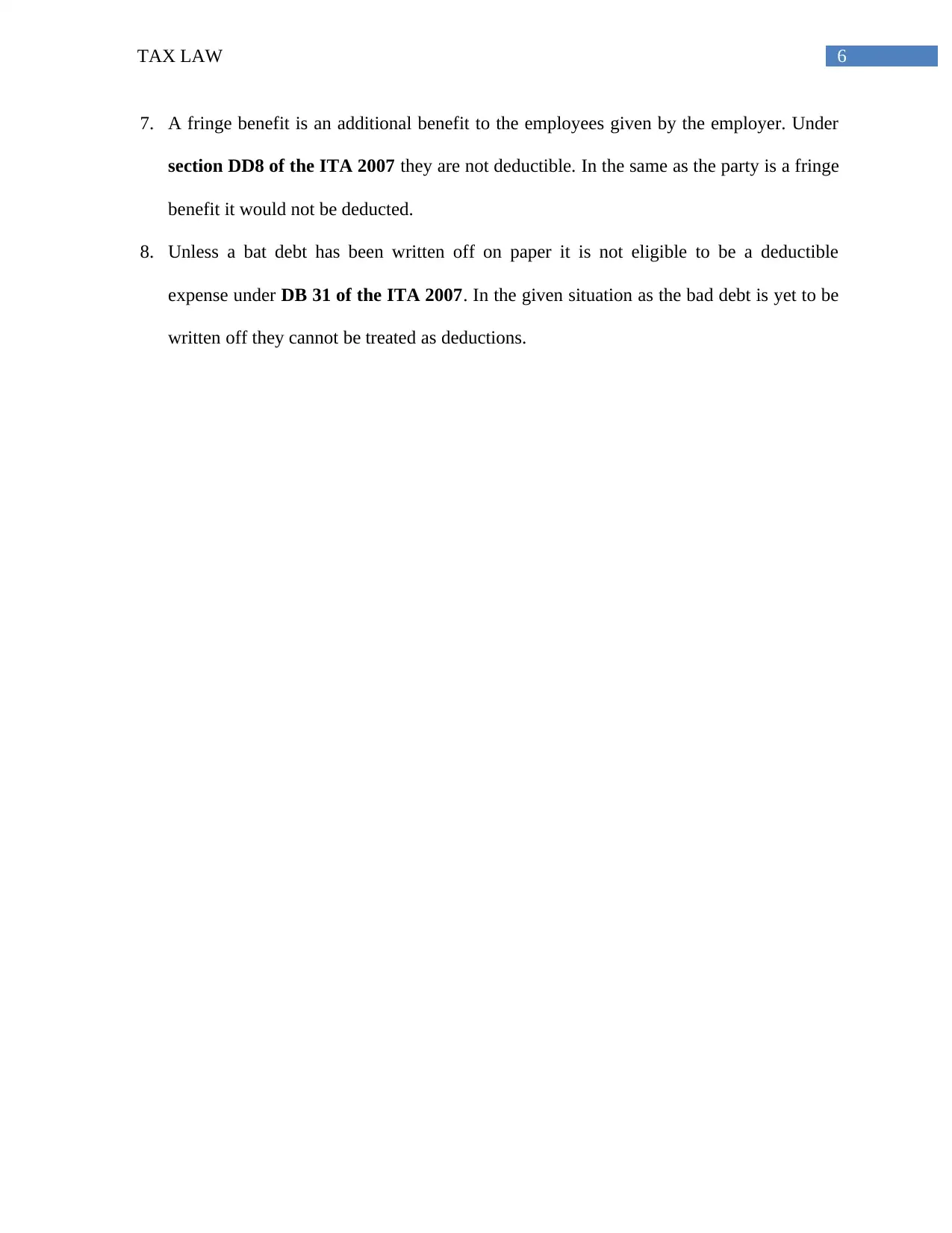
6TAX LAW
7. A fringe benefit is an additional benefit to the employees given by the employer. Under
section DD8 of the ITA 2007 they are not deductible. In the same as the party is a fringe
benefit it would not be deducted.
8. Unless a bat debt has been written off on paper it is not eligible to be a deductible
expense under DB 31 of the ITA 2007. In the given situation as the bad debt is yet to be
written off they cannot be treated as deductions.
7. A fringe benefit is an additional benefit to the employees given by the employer. Under
section DD8 of the ITA 2007 they are not deductible. In the same as the party is a fringe
benefit it would not be deducted.
8. Unless a bat debt has been written off on paper it is not eligible to be a deductible
expense under DB 31 of the ITA 2007. In the given situation as the bad debt is yet to be
written off they cannot be treated as deductions.
Paraphrase This Document
Need a fresh take? Get an instant paraphrase of this document with our AI Paraphraser
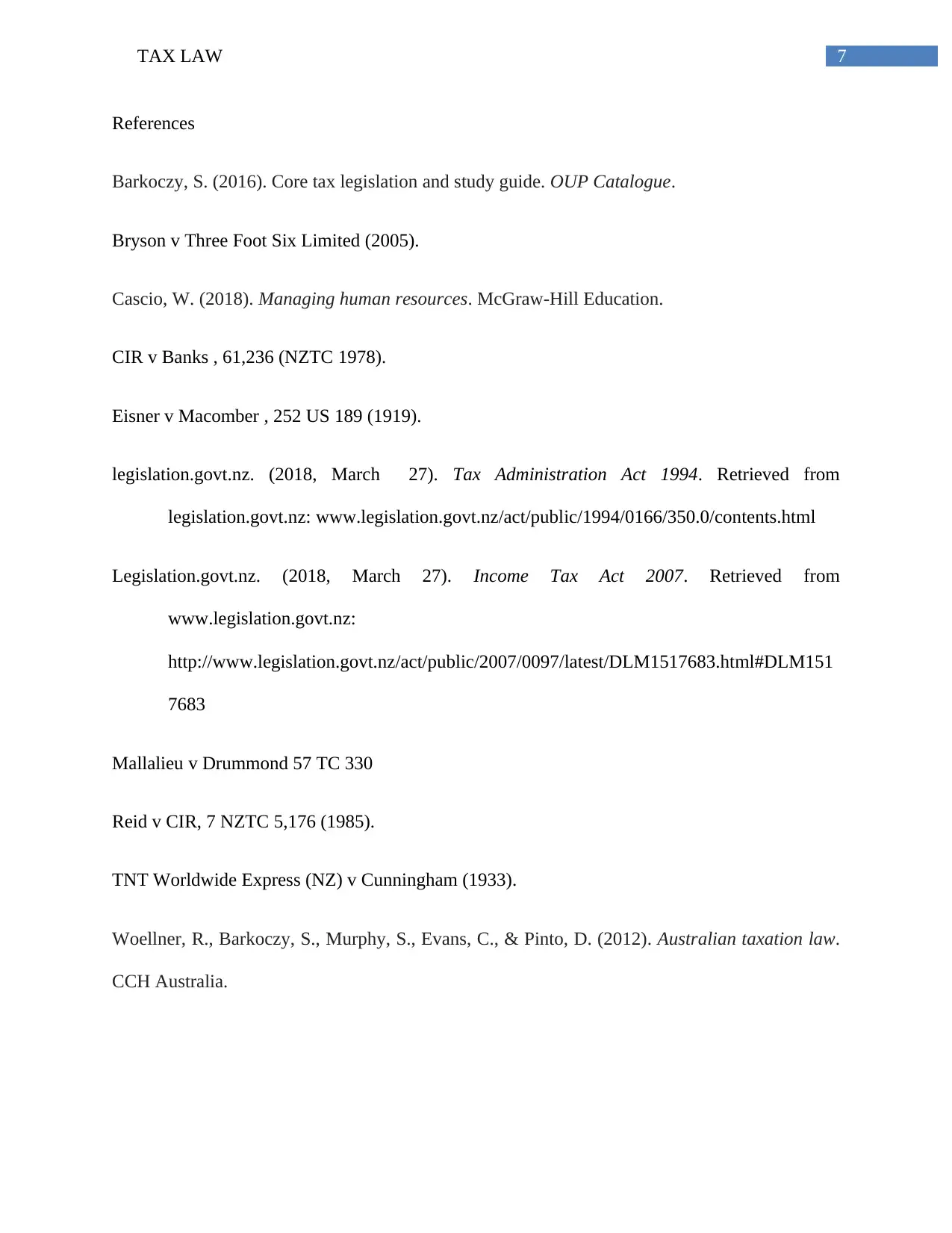
7TAX LAW
References
Barkoczy, S. (2016). Core tax legislation and study guide. OUP Catalogue.
Bryson v Three Foot Six Limited (2005).
Cascio, W. (2018). Managing human resources. McGraw-Hill Education.
CIR v Banks , 61,236 (NZTC 1978).
Eisner v Macomber , 252 US 189 (1919).
legislation.govt.nz. (2018, March 27). Tax Administration Act 1994. Retrieved from
legislation.govt.nz: www.legislation.govt.nz/act/public/1994/0166/350.0/contents.html
Legislation.govt.nz. (2018, March 27). Income Tax Act 2007. Retrieved from
www.legislation.govt.nz:
http://www.legislation.govt.nz/act/public/2007/0097/latest/DLM1517683.html#DLM151
7683
Mallalieu v Drummond 57 TC 330
Reid v CIR, 7 NZTC 5,176 (1985).
TNT Worldwide Express (NZ) v Cunningham (1933).
Woellner, R., Barkoczy, S., Murphy, S., Evans, C., & Pinto, D. (2012). Australian taxation law.
CCH Australia.
References
Barkoczy, S. (2016). Core tax legislation and study guide. OUP Catalogue.
Bryson v Three Foot Six Limited (2005).
Cascio, W. (2018). Managing human resources. McGraw-Hill Education.
CIR v Banks , 61,236 (NZTC 1978).
Eisner v Macomber , 252 US 189 (1919).
legislation.govt.nz. (2018, March 27). Tax Administration Act 1994. Retrieved from
legislation.govt.nz: www.legislation.govt.nz/act/public/1994/0166/350.0/contents.html
Legislation.govt.nz. (2018, March 27). Income Tax Act 2007. Retrieved from
www.legislation.govt.nz:
http://www.legislation.govt.nz/act/public/2007/0097/latest/DLM1517683.html#DLM151
7683
Mallalieu v Drummond 57 TC 330
Reid v CIR, 7 NZTC 5,176 (1985).
TNT Worldwide Express (NZ) v Cunningham (1933).
Woellner, R., Barkoczy, S., Murphy, S., Evans, C., & Pinto, D. (2012). Australian taxation law.
CCH Australia.
1 out of 8
Related Documents
Your All-in-One AI-Powered Toolkit for Academic Success.
+13062052269
info@desklib.com
Available 24*7 on WhatsApp / Email
![[object Object]](/_next/static/media/star-bottom.7253800d.svg)
Unlock your academic potential
Copyright © 2020–2025 A2Z Services. All Rights Reserved. Developed and managed by ZUCOL.





